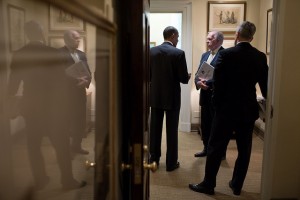Monday, WaPo made big news for reporting what Ron Wyden made clear 14 months ago: a key conclusion of the Senate Torture report is that CIA lied to Congress (and DOJ and the White House).
But much of this has been clear for even longer, having been exposed in some form in 2009-10.
Yet much of that got lost in CIA’s aggressive attack on Congress — one that anticipated what we’ve seen and will surely continue to see with the release of the Torture Report. At the time, CIA attempted to claim Congress had been fully briefed on torture, and therefore shouldn’t criticize the agency. Yet it gradually became clear how laughable CIA’s claims were. Along the way details of the lies CIA told in briefings came out.
The lies CIA told Congress in its first several years of the torture program include that it,
- Refused, at first, to reveal that the CIA relied on the September 17, 2001 Finding and therefore hid that the President had personally authorized the torture.
- Briefed on torture techniques that had happened months in the past, but claimed they had never yet been used.
- Falsely claimed CIA had not tortured before the August 1 memos purportedly authorizing it.
- Claimed Abd al Rahim al-Nashiri and Abu Zubaydah were not yet compliant as late as February 2003, even though they had been found compliant, after which CIA continued to use torture anyway.
- Claimed the torture tapes were a perfect match with what had been recorded in the torture log when a CIA OGC lawyer reviewed them in December 2002.
- Did not disclose the tapes had already been altered by the time CIA OGC reviewed them.
- Claimed the torture tapes had shown the torturers followed DOJ’s guidance when in fact they showed the torturers exceeded DOJ guidance.
- Misled regarding whether the detainees who had been killed had been tortured.
- Oversold the value of information provided by Abu Zubaydah.
- Lied about importance of torture in getting Abu Zubaydah to talk.
There are a number of claims CIA made that are almost certainly also false — most notably with regards to what intelligence came from torture — but most of that didn’t get recorded in the CIA’s records. I fully expect we’ll find details of those in the Senate Intelligence Committee report.
September 17, 2001: Bush signs “Gloves Come Off” Memorandum of Notification that authorizes capture and detention of top al Qaeda leaders, but leaves CIA to decide the details of that detention
Before I focus on the briefings, some background is in order.
Torture started as a covert operation authorized by the September 17, 2001 Memorandum of Notification. Under the National Security Act, the Intelligence Committees had to be briefed on that Finding and they were. However, the Finding was structured such that it laid out general ideas — in this case, the capture and detention of senior al Qaeda figures — and left the implementation up to CIA. As a result, key members of Congress (notably, Jane Harman, who was Ranking Member of the House Intelligence Committee for much of the period during which the program operated) apparently had no idea that the Finding they had been briefed on in timely fashion actually served as the Presidential authorization for torture until years later. Also, since that September 17, 2001 Finding authorized both torture and the outsourcing of nasty jobs to foreign intelligence partners, the earliest torture, such as that of Ibn Sheikh al-Libi in Egyptian custody starting in February 2002 and Binyam Mohamed in Pakistani custody starting in April 2002, should be considered part of the same covert op.
April to July 2002: CIA tortures Abu Zubaydah based solely on Presidential authorization
By now there is no dispute: the CIA started torturing Abu Zubaydah well before the August 1, 2002 memo that purportedly prospectively authorized that treatment. CIA even exceeded early verbal guidance on things like sleep deprivation, after which CIA unilaterally authorized what CIA had done retrospectively. The CIA appears to have gotten in real trouble when they moved to conduct mock burial with Abu Zubaydah, to which Ali Soufan objected; his objections appear to be the reason why mock burial (and by extension, mock execution) was the only technique John Yoo ultimately rejected. On July 13, after Michael Chertoff refused to give advance declination of prosecution to CIA for things they were ostensibly talking about prospectively but which had in fact already occurred, Yoo wrote a short memo, almost certainly coached by David Addington but not overseen by Yoo’s boss Jay Bybee, that actually served as the authorization CIA’s CTC would rely on for Abu Zubaydah’s torture, not the August 1 memos everyone talks about. As a result, CIA could point to a document that did not include limits on specific techniques and the precise implementation of those techniques as their authorization to torture.
CIA had, in internal documents, once claimed to have briefed the Gang of Four (then Porter Goss, Nancy Pelosi, Richard Shelby, and Bob Graham) in April 2002. But after being challenged, they agreed they did not conduct those briefings. This, then, created a problem, as CIA had not really briefed Congress — not even the Gang of Four — about this “covert op.”
Septmber 4, 2002: CIA provides initial trial balloon briefing to Pelosi and Goss, then starts destroying evidence
On September 4, 2002, 7 months after Egypt started torturing Ibn Sheikh al-Libi at America’s behest, almost 5 months after CIA started torturing Abu Zubaydah, and over a month after the OLC memo that purportedly started a month of torture for Abu Zubaydah, Jose Rodriguez, a CTC lawyer, and Office of Congressional Affairs head Stan Moskowitz first briefed Congress on torture techniques.
The record supports a claim that CIA provided some kind of description of torture to Nancy Pelosi and Porter Goss. It supports a claim that neither objected to the techniques briefed. Both Pelosi and Goss refer to this briefing, however, as a prospective briefing. Goss referred to the torture techniques as “techniques [that] were to actually be employed,” not that had already been employed, and when asked he did not claim they had been briefed on techniques that had been used. Pelosi claimed,
I was informed then that Department of Justice opinions had concluded that the use of enhanced interrogation techniques was legal. The only mention of waterboarding at that briefing was that it was not being employed.
Those conducting the briefing promised to inform the appropriate Members of Congress if that technique were to be used in the future.
Thus, at least as far as Goss and Pelosi are concerned, over a month after they first waterboarded Abu Zubaydah (and many more after Egypt had waterboarded al-Libi for us), CIA implied they had not yet done so with any detainee.
As striking as the evidence that CIA only briefed prospectively on torture that had been used for as many as 7 months, however, is what happened next. CIA moved to destroy evidence.
The day after that initial briefing in which CIA told Congress it might torture in the future, it “determined that the best alternative to eliminate those security and additional risks is to destroy these tapes.” Then, the following day, CTC altered its own notes on the substance of the briefing, taking out a sentence (it’s not clear what that sentence said). CIA’s Office of Congressional Affairs never finalized a description for this, and at one time even listed Jane Harman as the attendee rather than Pelosi. In fact, in a list of the briefings on torture compiled in July 2004, it did not treat this briefing as one covering torture at all.
In addition, for some reason a briefing for Bob Graham and Richard Shelby initially scheduled for September 9 got rescheduled for the end of the month, September 27. According to available records, Jose Rodriguez did not attend. According to Bob Graham’s notoriously meticulous notes, the briefing was not conducted in a SCIF, but instead in Hart Office Building, meaning highly classified information could not have been discussed. Graham says it chiefly described the intelligence the CIA claimed to have gotten from their interrogation program. Graham insists waterboarding did not come up, but Shelby, working off memory, disputes that claim.
February 4 and 5, 2002: CIA gets Republican approval to destroy the torture tapes, kills SSCI’s nascent investigation, and refuses to explain torture’s Presidential authorization
By November 2002, Bob Graham had started to hear vague rumors about the torture program. He did not, he says, receive notice that CIA froze Gul Rahman to death after dousing him with water or even hear about it specifically. But because of those rumors, Graham moved to exercise more oversight over the torture program, asking to have another staffer read into the program, and asking that a staffer see a Black Site and observe interrogation. That effort was thwarted in the first full briefing CIA gave Congress on torture on February 4, 2002, when CIA told Pat Roberts (who had assumed Senate Intelligence Chair; newly Ranking Member Jay Rockefeller was not present at this briefing, though a staffer was) they would not meet Graham’s requests. CIA claims — but Roberts disputes — that he said he could think of “ten reasons right off why it is a terrible idea” to exercise such oversight.
In addition to getting Roberts to quash that nascent assessment, CIA gave Roberts the following false information:
- CIA described Abu Zubaydah and Abd al Rahim al-Nashiri “as founts of useful information” about “on-going terrorist operations, information that might well have saved American lives.” While Abu Zubaydah provided some useful information, the “ongoing operations” were often invented. Moreover, of all the information Abu Zubaydah gave up under torture, just 10 bits of it were deemed important enough to appear in the 9/11 Report.
- CIA told Roberts about the “difficulty of getting that information from [Nashiri and Zubaydah], and the importance of enhanced techniques in getting that information.” Public records show CIA repeatedly attributed to Abu Zubaydah either things FBI had elicited without torture or things CIA learned via other means.
- CIA claimed Nashiri and Abu Zubaydah were not yet compliant. “[T]hey have not, even under enhanced techniques, revealed everything they know of importance.” Subsequent reports made clear that in both cases, they were fully compliant but people within CIA demanded more torture believing they were withholding information.
- To get Roberts to buy off on the destruction of the torture tapes, CIA told Roberts “the match” between what appeared in the torture tapes and what got recorded in CIA logs “was perfect” and that the CIA OGC lawyer who had reviewed the tapes “was satisfied that the interrogations were carried out in full accordance with the guidance.” While it is in fact true that CIA OGC claimed the tapes were an exact match, in fact the tapes had already been significantly altered (and the taping system had been shut down for some torture sessions), and the tapes showed that the torturers had not followed DOJ’s guidelines on torture. CIA also appears to have neglected to tell Roberts that 2 of the tapes showed interrogations involved Nashiri.
The Memorandum of Understanding of this briefing appears to be one of only two that got finalized (it actually included a reference that Goss and Harman had been briefed on the torture tape, but not that Harman warned against destroying it).
The February 5, 2003 briefing involving Porter Goss and Jane Harman is just as interesting, though CIA has refused to release their notes from it.
Five days after the briefing, Harman wrote a letter questioning whether torture had been reviewed from a policy perspective and advising against destroying Abu Zubaydah’s torture tape. In addition, she asked if the President had signed off, revealing that she didn’t know that the Finding she had been briefed on included torture. The CIA and the White House met to decide how to respond. In the end, CIA General Counsel Scott Muller’s response didn’t really answer any of Harman’s questions, nor note her warning against destroying the torture tape.
Also note: in the month before these briefings, the CIA prepared what appears to be a tear-line document on Abu Zubaydah. While it’s not certain the document was prepared to brief the Gang of Four, it matches what we know to have been said to Roberts, especially as regards to the torture tapes. But it also reveals real discrepancies between the tear-line (Secret) claims and the Top Secret claims it was based on, notably inflating the value of Abu Zubaydah’s intelligence below the tear-line.
September 4, 2003: An innocuous briefing left off some of the tracking
We don’t really know what happened in the September 4, 2003 briefings of both Goss and Harman and Roberts and Rockfeller, which is a shame because it would have covered Khalid Sheikh Mohammed’s treatment (and that of Ammar al-Baluchi, whom we now know may have been treated even worse than his uncle). In fact, it was left off lists of “sensitive” briefings at different times.
July 2004: CIA has to tell Congress even CIA(‘s IG) thinks they lied
On May 7, 2004, CIA’s IG John Helgerson completed his report finding that the torture had exceeded guidelines and questioning the value of the intelligence obtained using it. On June 23, the Roberts and Rockefeller got copies (it’s not clear whether Goss and Harman got advance copies). On July 13, 2004, CIA briefed Goss and Harman again.
The briefing did include some details from CIA IG John Helgerson’s report on the program — that it violated the Convention Against Torture and did not comply with the OLC memos. He also explained that both Abu Zubaydah and Khalid Sheikh Mohammed’s waterboarding was problematic, the first in execution and the second in number.
As part of that briefing (or by reading the IG Report), Harman learned that the Finding authorized this torture; in the briefing she pointed out the Finding had only authorized detention and capture, not interrogation.
But CIA persisted in a narrow dodge and two false claims:
- CIA claimed that none of the at least 3 or 4 detainees who had died in CIA custody by that point were in the interrogation program; by that, it meant only that they weren’t part of the RDI program, but CIA did in fact torture them before they died.
- CIA claimed we had not used any torture before the OLC memos, which is only true if you ignore that al-Libi and Mohamed’s torture was carried out by proxies.
- CIA claimed it did not start torturing Abu Zubaydah until August 1; in reality, they had started torturing him earlier.
There are few details on the briefing CIA gave Roberts and Rockefeller on July 15.
These are just the details of the lies CIA itself has documented and released CIA telling Congress. There are other allegations of CIA lies in briefings, though those records were not released under FOIA. And things started getting really funky in 2005, as Dick Cheney started participating in CIA briefings to try to defeat the Detainee Treatment Act. In addition, CIA briefed Pete Hoekstra (who had become the Chair of the House Intelligence Committee) on the morning they destroyed the torture tapes; the content of that briefing has never been revealed.
None of this excuses Congress, of course: the knew enough to know this was problematic.
But it is clear that CIA lied to them both to boost the value of the torture they were doing and to diminish the problems and abuses.



